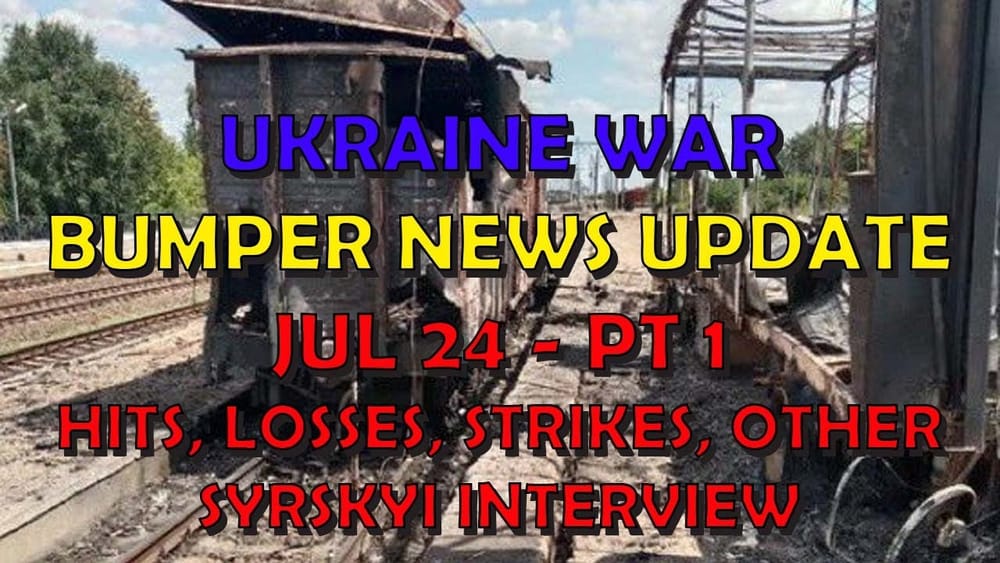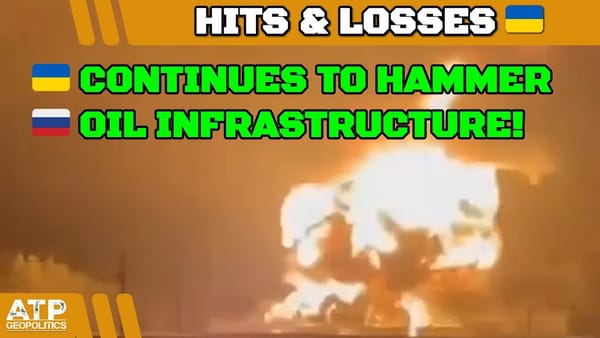Ukraine War Update BUMPER NEWS: Pt 1 - Overnight & Other News
Table of Contents 📖
"We don't defend ruins to the death."
Hello Team
🎦 00:00-00:40⏩
Jonathan welcomes everyone to a bumper Ukraine War News update and reminds viewers about the daily updated Oryx/Dell's spreadsheets that are in the description.
Return to top⤴️
🪦 DISCLAIMER FOR GENERAL STAFF LOSSES DATA
- These are real people with real lives and real families who love them. Don’t let the numbers sap your humanity.
- These numbers probably aren’t accurate but they’re the best we have and we don’t need them to be accurate to be indicative of patterns of activity.
- All losses are estimates. Losses cannot be counted with accuracy because of the conditions on the ground.
- Both sides would see it to be of their advantage to minimize their own losses maximize the other side’s losses.
- Neither side releases their losses but we have enough transparency from the Ukrainian side to have confidence in they are indicative.
- Personnel losses are hard to count. If a soldier gets injured, heals up, and returns to the front line only to get injured again, is that one loss or two? Also, how to deal with losses from PMC’s or soldiers fighting with RF from occupied territories?
- Equipment losses are hard to count. If an AA complex involves several parts and one part gets disabled, is that a loss, or a fraction of a loss? If a tank gets disabled, repaired, back into the fight, then disabled again, is that one lost tank or two?
- All recorded losses are vulnerable to multiple reporting. We have already seen numerous cases of multiple drones in the air reporting the same loss from different angles as multiple engagements.
- Losses are not always reported on the same day they occurred. It is frequent that drone losses are reported at least 24 hours after other terrestrial equipment losses. Certain losses may not be reported for days or weeks for military intelligence reasons.
Russian Equipment and Personnel Losses for 23/07/2024
🎦 00:40-03:45⏩
Jonathan reviews the Ukrainian General Staff figures for Russian losses from the 23/07/2024:
- 1140 personnel.
- 14 Tanks.
- 13 APVs.
- 65 Artillery Systems (almost 4 times the daily average).
- 1 Air Defence System.
- 1 Aircraft.
- 77 Vehicles and Fuel Tanks.
- 10 Special Equipment.
Analysis of Andrew Perpetua's Russian Equipment Losses - 23/07/2024
🎦 03:45-05:48⏩
Jonathan analyses the equipment losses visually confirmed by Andrew Perpetua from 23/07/2024: Ukrainian Losses:
- Artillery: A number of M777s, older Howitzers, 1 B-21 Grad.
- Tanks: 1 Abandoned M1 Abrams.
- Infantry Fighting Vehicles: 1 Rosamac, 1 BMP-2, and 1 MaxxPro MRAP.
Russian Losses:
- A substantial amount of surveillance and communications equipment.
- 1 Yastreb AEW&C Radar.
- Tanks: 5 various Tanks.
- Infantry Fighting Vehicles: Several destroyed, primarily BMP-1s, BMP-2s, and BTRs.
- A variety of other vehicles including Kamaz Trucks, other Trucks, 1 Quad, a Golf Buggy, Desert Cross 1000-3, Motorcycles, Loaf Bukankas, Scooby-Doo Vans, Pickup Loafs, and Flatbed Loafs.
Jonathan highlights the significance of the loss of the Yastreb AEW&C Radar, valued at $250 million, noting that this alone outweighs all Ukrainian losses. He describes it as a "very bad day for the Russians, both in terms of mass and the high value of that radar."
Return to top⤴️
Analysis of Andrew Perpetua's Russian Equipment Losses - 24/07/2024
🎦 05:48-09:05⏩
Jonathan reviews Andrew Perpetua's equipment losses from 24/07/2024: Ukrainian Losses:
- 1 Dingo 2 MRAP.
- 1 M113.
- A couple of MaxxPro MRAPS.
Russian Losses:
- Aircraft: 1 Su-25, 1 Buk Air Defence System.
- 1 Electronic Warfare System.
- 1 Recovery Vehicle.
- 1 Grad.
- A number of other Howitzers.
- Tanks: A large number including T-62s, T-80s, and T-72 variants. Most were destroyed and abandoned, rather than damaged.
- Infantry Fighting Vehicles: A large number with almost all destroyed and abandoned including BMP-1s, BMP-2s, and BTRs.
- APCs: Most destroyed and abandoned, with a mix of older vehicles including BTR-70s, BTR-80s, and a BTR-50.
- Other Vehicles: Multiple Golf Carts, Desert Cross 1000-D3s, and civilian vehicles.
Jonathan observes the continuation of a trend where Russians are losing a substantial amount of equipment, including high-value assets like a Buk air defense unit and an Su-25. He points out the significance of vehicles being abandoned, as it usually indicates their eventual destruction or capture. The presence of older vehicles reflects Russia's increasing desperation.
Return to top⤴️
Analysis of Russian Equipment Losses in the Prokrosk Region
🎦 09:05-10:18⏩
Jonathan examines data revealing a "shocking" ratio of equipment losses in the Prokrosk region:
- Russians: 1,500 pieces of equipment lost.
- Ukrainians: 300 pieces of equipment lost.
Jonathan points out that this equates to a 5:1 loss ratio, highlighting the region as particularly challenging for Russian forces since October 2023. He observes that while these specific ratios might not apply uniformly across the entire front line, they represent the broader trend of Russia suffering considerably higher equipment losses than Ukraine.
Return to top⤴️
Guardian Interview - General Oleksandr Syrskyi
🎦 10:18-21:44⏩
Jonathan delves into a Guardian article by Luke Harding, featuring an interview with General Oleksandr Syrskyi, the commander of Ukrainian ground forces. Key takeaways include:
- Russian Force Strength: The initial invasion force of 100,000 has swelled to 520,000, with plans to reach 690,000 by the end of 2024.
- Equipment Ratio: Syrskyi states that Russia maintains a significant advantage in equipment, with ratios ranging from 2:1 to 3:1 in their favour.
- Russian Tank Numbers: Since 2022, the number of Russian tanks in the conflict zone has doubled from 1,700 to 3,500.
- Artillery Systems: Russian artillery systems have tripled.
- Armoured Personnel Carriers: Numbers have increased from 4,500 to 8,900.
- Importance of Quality: Syrskyi emphasises the need for Ukraine to counter Russia's numerical superiority with superior equipment, enabling them to maintain a positive kill ratio.
- Tactical vs. Strategic Gains: He downplays recent Russian gains as tactical rather than operational or strategic breakthroughs, noting that the front line stretches over 3,700 kilometres, with active combat along 977 kilometres.
- Human Cost: Syrskyi reveals that Russian casualties are three times higher than Ukraine's, highlighting the Kremlin's willingness to sacrifice troops for minimal territorial gains.
- Preserving Ukrainian Lives: Syrskyi underscores Ukraine's commitment to preserving the lives of its soldiers, contrasting their approach with Russia's.
- F-16 Deployment: Syrskyi clarifies that F-16s will operate no closer than 40 kilometres from the front lines due to the threat posed by Russian air defenses.
- Drone Warfare: He highlights the growing importance of drones in Ukraine's strategy, both for striking targets deep inside Russia and for supporting ground operations.
- Kamikaze Drone Strikes: Ukraine has successfully used long-range kamikaze drones to hit approximately 200 critical infrastructure targets in Russia, including factories, fuel depots, and ammunition storage facilities.
- Sea Drone Success: Sea drones have inflicted significant damage on Russia's Black Sea Fleet, sinking about a third of its vessels.
Jonathan pauses to acknowledge a user comment, thanking Ivan for the tea. He expresses frustration at the lack of transparency and proper sourcing by certain online outlets, specifically calling out Max24 for misrepresenting Syrskyi's words.
Return to top⤴️
Footage of Su-25 Downing & Manpad Shortages
🎦 23:58-25:16⏩
Jonathan discusses widely circulated footage showing a Ukrainian Stinger missile successfully shooting down a Russian Su-25. He highlights that the pilot ejected and was recovered. This incident underscores the importance of man-portable air-defense systems (MANPADS) like Stingers. Jonathan mentions previous reports of shortages of such systems among Ukrainian forces and notes ongoing efforts to train Ukrainian personnel on the UK-supplied Martlet MANPADS.
Return to top⤴️
Russian Tank Production Capacity & Depletion of Stores
🎦 25:16-27:03⏩
Jonathan discusses an interview with Jack Watling of the Royal United Services Institute (RUSI), where Watling asserts that Russia has the capacity to refurbish and produce 1,500 tanks in 2024 and 2025. However, Jonathan expresses disagreement, citing recent satellite imagery analysis from Oryx indicating a slowdown in the rate of tank removals from storage depots.
- Oryx Analysis: Only 800 tanks removed from visible storage between mid-2023 and mid-2024.
Jonathan believes that Watling is overestimating Russia's production capacity. He points out that as the conflict continues, Russia is increasingly forced to pull more damaged equipment from storage, which requires more time-consuming and costly repairs. Jonathan reasons that this factor likely contributes to the observed decline in tank removal rates. Jonathan analyses further open-source intelligence (OSINT) suggesting that Russia has been prioritizing the refurbishment of T-72B and T-80 tanks, leaving older models like the T-72 and T-64 largely untouched. He argues that attempting to refurbish these older tanks would result in even lower reactivation rates.
Return to top⤴️
Assassination Attempt on Russian Military Official in Moscow
🎦 27:03-27:55⏩
Jonathan reports on a car bomb attack in Moscow targeting a high-ranking Russian military officer.
- Target: Andrei Torgeshev, Deputy Head of the 89th Satellite Communication Centre of the Russian Armed Forces.
- Outcome: Torgeshev was severely injured, losing both legs in the explosion.
Jonathan notes the audacity of the attack, demonstrating Ukraine's continued ability to conduct operations within Russia. He infers that this is part of an ongoing campaign of targeted assassinations against Russian military and intelligence figures.
Return to top⤴️
Ukrainian Air Defence Intercepts Overnight 23/07 - 24/07/2024
🎦 27:55-28:32⏩
Jonathan details the results of Ukrainian air defense operations overnight:
- Shot Down: 8 Reconnaissance Drones, 17 out of 23 Shahed drones.
- Not Intercepted: 1 Iskander-M Missile, 1 Missile of Unknown Type.
While the interception rate for Shahed drones was slightly lower than usual at approximately 75%, Jonathan emphasizes that the overall performance remains satisfactory.
Return to top⤴️
S-300 Use Against Kharkiv & Air Defence System Vulnerability
🎦 28:32-30:25⏩
Jonathan expresses concern and puzzlement over reports of Russia using S-300 air defense systems in their ground attack role to target Kharkiv. He notes that this tactic has been employed before, during the initial phase of the Russian offensive towards Kharkiv, which resulted in significant losses of these systems due to Ukrainian counterattacks. Jonathan questions the strategic logic behind this decision. He argues that deploying S-300s, already in limited supply, for relatively low-value targets like Kharkiv exposes them to unnecessary risks and depletes Russia's overall air defence network. He suggests that the resources would be better allocated to protecting higher-value assets and bolstering air defenses in occupied territories. Jonathan believes that the continued use of S-300s in this manner will lead to their destruction by Ukrainian forces.
Return to top⤴️
Russian Strikes on Odessa and Ismail
🎦 30:25-31:31⏩
Jonathan reports on Russian missile and drone strikes targeting the port city of Odessa and the Danube River port of Izmail.
- Odessa: A five-story apartment building was hit, though it remains unclear whether it was directly targeted or hit by errant munitions.
- Izmail: Port infrastructure was damaged in the attacks.
Jonathan highlights reports suggesting that a Russian drone may have also landed and exploded in the Romanian village of Plauru. He notes the significant attention drawn by the Odessa attacks and the overall increase in Russian military activity in the region.
Return to top⤴️
Energy Infrastructure, Blackouts & Decentralization
🎦 31:31-45:21⏩
Jonathan shifts focus to the impact of the ongoing conflict on Ukraine's energy infrastructure.
- Blackouts in Dnipro: BBC reporter James Waterhouse reports that residents in Dnipro are experiencing severe power outages, with electricity available for only two hours out of every nine due to Russian strikes on energy facilities.
- Widespread Energy Crisis: Jonathan acknowledges that the Russian campaign targeting Ukraine's energy grid has caused the worst blackouts witnessed since the start of the war.
- Decentralisation as a Solution: Jonathan reiterates a point he made over a year ago, advocating for Ukraine to decentralize its energy production. He argues that transitioning towards solar and wind power would make the energy grid more resilient to attacks, as it would be far more difficult for Russia to disable numerous smaller, dispersed power sources.
- Benefits Beyond Security: Jonathan, while acknowledging his personal support for renewable energy, emphasizes that decentralisation is not just about environmental concerns but also about ensuring the long-term sustainability and security of Ukraine's energy supply. He suggests that a widespread adoption of household solar and wind power would reduce reliance on centralized power plants and free up capacity for industrial needs.
- DTEK's Optimistic Outlook: Jonathan cites an optimistic forecast from DTEK, a major private energy producer in Ukraine, predicting a restoration of 60%-70% of their energy output by year-end.
Logistical Problems and Shortages for Russian Forces
🎦 45:21-48:17⏩
Jonathan pivots to discuss the growing logistical challenges and shortages plaguing Russian forces.
- Sevastopol University Dormitory Construction Workers Unpaid: Construction workers tasked with building dormitories for Sevastopol University have reportedly not been paid for three months, prompting complaints about their inability to support their families.
- Water Shortages for Russian Pilots: ChrisO_wiki reports that Russian fighter pilots stationed in Ukraine and southern Russia are facing severe water shortages, receiving a meagre one litre per day despite the extreme heat.
- Fighter Bomber Telegram Channel Reports: The Fighter Bomber Telegram channel, known for its reliability, published a post detailing a chronic lack of food and water for Russian pilots operating from forward airfields. After complaints, food rations were reportedly improved but the water situation remains dire, with pilots resorting to seeking water from nearby villages.
- Health Concerns: The US National Academies of Sciences, Engineering, and Medicine recommends a daily intake of 3.7 litres of water, particularly in hot climates, warning that inadequate consumption can lead to dehydration.
- Drought and Infrastructure Damage Exacerbating Shortages: The destruction of the Kakhovka Dam in June 2023, coupled with a heatwave and drought, has severely limited Crimea's water supply.
Jonathan connects these accounts, painting a picture of widespread resource scarcity affecting Russian forces, impacting morale, and hindering their operational capabilities.
Return to top⤴️
Ukrainian Retreat, Encirclement Risk, and Political Developments
🎦 48:17-49:46⏩
Jonathan covers a mix of military setbacks and political developments.
- Ukrainian Retreat in Avdiivka: DeepState reports a critical situation on the Avdiivka front, where a Ukrainian infantry brigade conducted a chaotic retreat after receiving inadequate training. The 47th Mechanized Brigade, known for its combat effectiveness, was unable to hold the town due to a shortage of infantry.
- Encirclement Risk: A pocket has formed north of Avdiivka, putting the 1st and 3rd battalions of Ukraine's 31st Mechanized Brigade at risk of encirclement. No withdrawal orders have been given.
- Previous Incidents: Jonathan notes this isn't the first time such a situation has arisen in Avdiivka, alluding to a similar incident where a unit's retreat left other units vulnerable.
- Yermak-Gordon Meeting: Andriy Yermak, Head of the Office of the President of Ukraine, held talks with Phil Gordon, a former US diplomat and national security expert.
Jonathan highlights the significance of Yermak's meeting with Gordon, particularly in light of potential future political shifts in the US. He posits that if Kamala Harris wins the upcoming US presidential election, Gordon, a strong advocate for Ukraine, is likely to become her national security advisor.
Return to top⤴️
Wrap up
🎦 49:46-49:53⏩
Jonathan thanks viewers for watching and acknowledges the length of the update, attributing it to the significant amount of news.
Return to top⤴️




